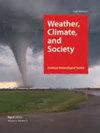Tweeting the Heat: An Analysis of the National Weather Service's Approach to Extreme Heat Communication on Twitter
IF 1.9
4区 地球科学
Q3 ENVIRONMENTAL STUDIES
引用次数: 0
Abstract
Abstract Heat communication interventions are an essential way that public safety organizations can reduce extreme heat consequences for at-risk groups. Although the aim of these interventions is typically behavior change, these organizations commonly assume that providing information about heat risks, impacts, vulnerable populations, and protective actions will lead individuals to protect themselves. However, behavior change is a complex process whereby messages must be crafted in ways that increase their persuasive effects. To examine the extent to which key assumptions about behavior change are present in public safety organizations’ heat communication interventions, we examine 250 heat-related tweets sent by seven National Weather Service (NWS) weather forecast offices (WFOs) in 2021. We find that these NWS WFOs use technical language or “jargon” to communicate about heat risks and impacts. In addition, we find that information about vulnerable populations and protective actions is not presented in a way that conforms to theory on behavior change. Based on these results, we offer recommendations to increase the persuasiveness of NWS WFO communication interventions that encourage the public to protect themselves during extreme heat events. Significance Statement Heat is the leading cause of death among all weather-related hazards. How heat is communicated to the public can help mitigate heat-related morbidity and mortality. However, heat communication interventions are often developed with several embedded assumptions about behavior change that negatively impact their effectiveness. By examining how a key public safety organization communicates about heat on social media, and the extent to which these assumptions are present, we offer recommendations to increase the persuasiveness of NWS heat communication on social media.推特热:分析国家气象局在推特上的极端高温传播方法
热传播干预是公共安全组织减少高危人群极端高温后果的重要途径。虽然这些干预措施的目的通常是改变行为,但这些组织通常认为,提供有关高温风险、影响、脆弱人群和保护措施的信息将引导个人保护自己。然而,行为改变是一个复杂的过程,在这个过程中,信息必须以增加其说服力的方式精心制作。为了检查公共安全组织的热传播干预措施中存在的关于行为变化的关键假设的程度,我们检查了2021年七个国家气象局(NWS)天气预报办公室(wfo)发送的250条与热相关的推文。我们发现这些NWS wfo使用技术语言或“行话”来传达热风险和影响。此外,我们发现关于弱势群体和保护行动的信息并没有以符合行为改变理论的方式呈现。基于这些结果,我们提出了建议,以提高NWS WFO传播干预措施的说服力,鼓励公众在极端高温事件中保护自己。在所有与天气有关的危害中,高温是导致死亡的主要原因。如何将热量传达给公众可以帮助减少与热有关的发病率和死亡率。然而,热传导干预通常是与一些对行为改变产生负面影响的嵌入假设一起开发的。通过研究一个重要的公共安全组织如何在社交媒体上传播热量,以及这些假设存在的程度,我们提出了增加NWS在社交媒体上传播热量的说服力的建议。
本文章由计算机程序翻译,如有差异,请以英文原文为准。
求助全文
约1分钟内获得全文
求助全文
来源期刊

Weather Climate and Society
METEOROLOGY & ATMOSPHERIC SCIENCES-
CiteScore
3.40
自引率
13.60%
发文量
95
审稿时长
>12 weeks
期刊介绍:
Weather, Climate, and Society (WCAS) publishes research that encompasses economics, policy analysis, political science, history, and institutional, social, and behavioral scholarship relating to weather and climate, including climate change. Contributions must include original social science research, evidence-based analysis, and relevance to the interactions of weather and climate with society.
 求助内容:
求助内容: 应助结果提醒方式:
应助结果提醒方式:


